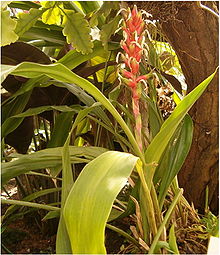Pitcairnioideae
| Pitcairnioideae | ||||||||||||
|---|---|---|---|---|---|---|---|---|---|---|---|---|

Deuterocohnia lorentziana , a small, succulent, cushion-forming species with greenish flowers |
||||||||||||
| Systematics | ||||||||||||
|
||||||||||||
| Scientific name | ||||||||||||
| Pitcairnioideae | ||||||||||||
| Harms |
Pitcairnioideae is a subfamily of the family of plants of the Bromeliaceae (Bromeliaceae). The individual subfamilies differ particularly in the type of fruit and the structure of the flower. It contains only five genera with about 670 species in the Neotropic .
features


Species in this subfamily Pitcairnioideae have more original characteristics than the species in the subfamilies Bromelioideae and Tillandsioideae . Only species in the genera that are not assigned to any of these three subfamilies have even more original characteristics.
The representatives of the Pitcairnioideae differ from the other subfamilies of the Bromeliaceae in the following characteristics:
- Ovary : upper or semi-protruding.
- Fruits : capsules with many airworthy seeds that have comb, hood or thread-shaped appendages.
- Leaves : entire or prickly.
- mostly terrestrial , i.e. growing on the ground. (In the two other subfamilies, the epiphytes predominate ).
- Flower formula :
Systematics and distribution
The distribution area extends from the southern states of the USA to Argentina and the Caribbean islands.
One species from this subfamily, Pitcairnea feliciana , is native to West Africa . All other Bromeliaceae are purely New World spread. This fact was also used to prove the continental drift . This species is one of the most original members of the Bromeliaceae family. The oldest fossil finds believed to be the origin of the Bromeliaceae date back to when Africa and South America together formed the continent of Gondwana and were found in arid regions.
Today belong to the subfamily Pitcairnioideae s. st. only five genera with about 670 species. Most of the species of the genus Pepinia are contained in the genus Pitcairnia , if an author disagrees , then there are six genera (as of 2014) :
- Deuterocohnia Mez : It occurs in the South American Andes and contains about 18 species, including the species of the former genus Abromeitiella Mez .
- Dyckia Schult. f. : It contains about 168 species arewidespreadin Brazil , Argentina , Bolivia , Paraguay and Uruguay .
- Encholirium Mart. ex Schult. f. : The only 29 species left since 2014 are only found in Brazil.
- Fosterella L.B.Sm. : The 31 to 33 species are almost all distributed in central South America, only one species occurs in Central America.
- Pitcairnia L'Her. (Syn .: Cochliopetalum Beer , Conanthes Raf. , Hepetis Sw. , Lamproconus Lem. , Melinonia Brongn. Ex E. Morren , Neumannia Brongn. , Orthopetalum Beer , Phlomostachys Beer , Spirastigma L'Her. Ex Pfeiffer , Willrussellia A. Chev. , Pepinia Brongn. Ex André ): It contains about 400 species if Pepinia is included. The neotropical distribution area extends from southern Mexico over the Caribbean islands to northern Argentina and Peru.
swell
- The Bromeliaceae family on the AP website. (Section systematics)
- HE Luther: An Alphabetical List of Bromeliad Binomials , 2008 ( Memento June 17, 2012 in the Internet Archive ) in The Marie Selby Botanical Gardens, Sarasota, Florida, USA. Published by The Bromeliad Society International. (PDF file; 314 kB)
- Werner Rauh : Bromeliads - Tillandsias and other bromeliads worthy of culture. Verlag Eugen Ulmer, Stuttgart 1990. ISBN 3-8001-6371-3
- Eric J. Gouda, Derek Butcher, Kees Gouda: Select taxon in "Species Index" at Encyclopaedia of Bromeliads, Version 3.1, 2012. last viewed on December 5, 2014 (section systematics)
Individual evidence
- ^ HE Luther, 2008: An Alphabetical List of Bromeliad Binomials in The Marie Selby Botanical Gardens, Sarasota, Florida, USA. Published by The Bromeliad Society International. Pp. 73-76
- ↑ a b c d e In "Species Index" click on Racinaea in Eric J. Gouda, Derek Butcher & Kees Gouda: Encyclopaedia of Bromeliads , Version 3.1 (2012). last accessed on December 5, 2014
further reading
- TJ Givnish, JC Pires, SW Graham, MA McPherson, LM Prince, TB Patterson: Phylogeny, biogeography, and ecological evolution in Bromeliaceae: Insights from ndhF sequences. In: JT Columbus, EA Friar, JM Porter, LM Prince, MG Simpson: Monocots: Comparative Biology and Evolution. Poales , Rancho Santa Ana Botanical Garden, Claremont, 2006, 23, pp. 3-26.
